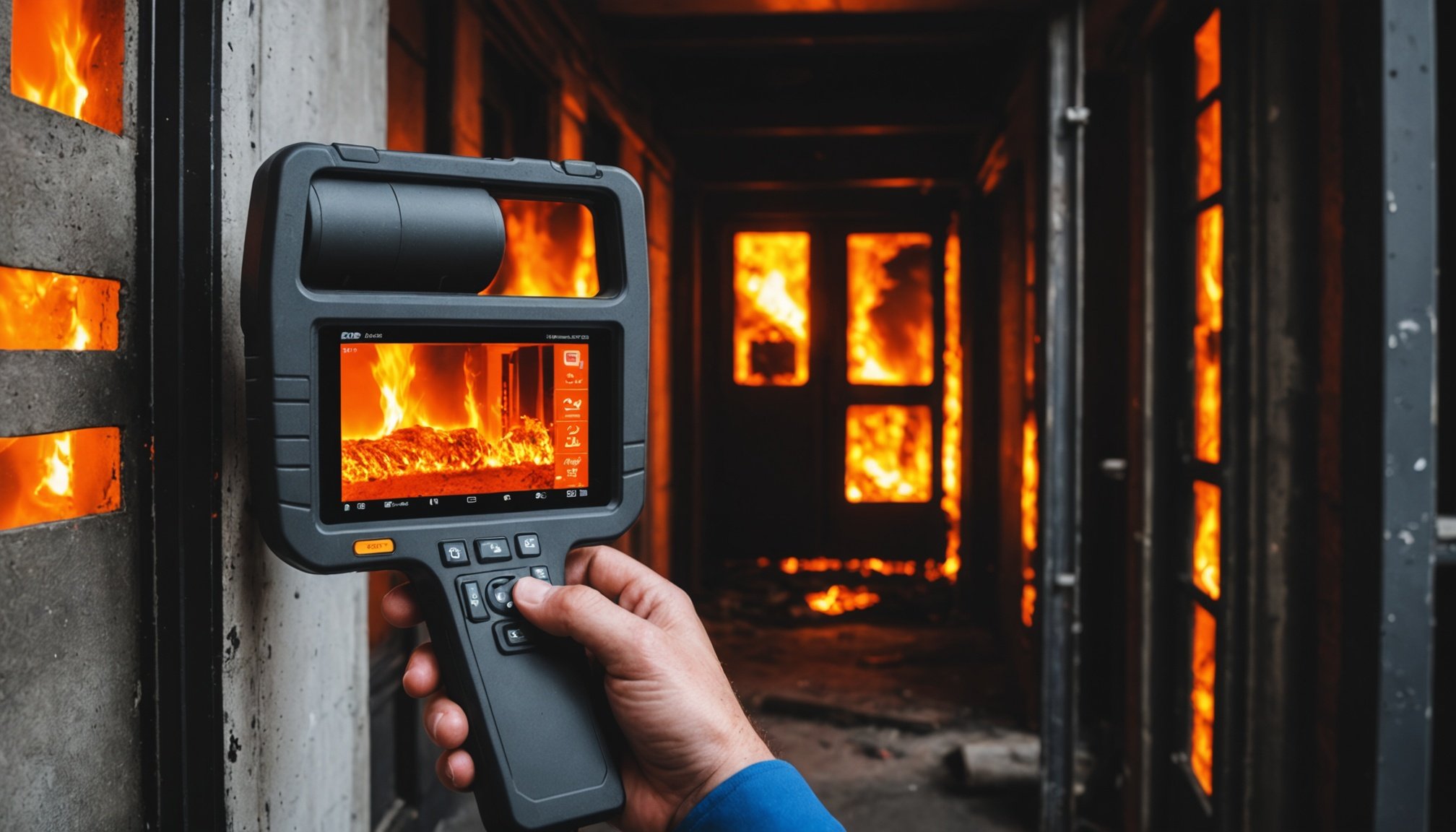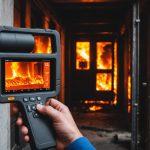Revolutionizing Fire Safety in UK Buildings: The Impact of Advanced Thermal Imaging Technology
The Evolving Landscape of Fire Safety
Fire safety has been a paramount concern for buildings across the UK, with stringent regulations and continuous advancements in technology aimed at mitigating fire risks. One of the most significant breakthroughs in recent years is the integration of advanced thermal imaging technology into fire safety systems. This innovation is transforming the way we detect, prevent, and manage fires, making buildings safer and more efficient.
Understanding Thermal Imaging Technology
Thermal imaging, also known as thermography, involves the use of cameras that detect heat rather than visible light. These cameras can identify temperature variations in real-time, which is crucial for early fire detection. Here’s how it works:
Additional reading : Revolutionizing Security: The Role of Quantum Computing in Elevating Cryptography for Financial Transactions
- Heat Detection: Thermal cameras can spot even slight increases in temperature, often before a fire is visible to the naked eye or before smoke is detected by traditional smoke alarms.
- Real-Time Data: This technology provides real-time data, allowing for immediate action to be taken in the event of a potential fire.
- Energy Efficiency: By monitoring temperature changes, thermal imaging can also help in identifying energy inefficiencies in buildings, such as insulation gaps or malfunctioning heating systems.
Applications in Fire Safety Systems
Advanced thermal imaging technology is being integrated into various aspects of fire safety systems in UK buildings.
Fire Detection
Thermal imaging cameras are being used as part of advanced fire detection systems. Here are some key benefits:
Also to discover : Transforming enterprise security: the impact of next-generation firewalls on modern defense strategies
- Early Detection: Thermal cameras can detect fires at an early stage, often before they spread and cause significant damage.
- Reduced False Alarms: Unlike traditional smoke detectors, thermal cameras are less prone to false alarms caused by dust, steam, or other non-fire related particles.
- Continuous Monitoring: These cameras can monitor areas continuously, providing 24/7 surveillance.
Fire Protection and Suppression
Thermal imaging is also enhancing fire protection and suppression systems:
- Smart Building Integration: Thermal imaging data can be integrated into smart building management systems, allowing for automated responses to fire threats, such as activating sprinkler systems or fire suppression mechanisms.
- Fire Door Monitoring: Thermal cameras can monitor fire doors to ensure they are functioning correctly and not compromised by heat.
Case Studies and Success Stories
Several UK buildings have already seen the benefits of advanced thermal imaging technology.
Example: High-Rise Buildings
In a recent implementation in a high-rise office building in London, thermal imaging cameras were installed to monitor common areas and electrical rooms. Within the first month, the system detected a slight temperature increase in an electrical panel, which was addressed before it could escalate into a fire. This early detection prevented potential damage and ensured the safety of occupants.
Example: Industrial Facilities
An industrial facility in Manchester integrated thermal imaging into their fire safety system to monitor machinery and electrical equipment. The system alerted maintenance staff to a overheating motor, which was replaced before it caused a fire. This proactive approach not only enhanced fire safety but also improved overall operational efficiency.
Comparative Analysis of Traditional vs. Advanced Fire Safety Systems
Here is a comparative table highlighting the differences between traditional fire safety systems and those enhanced with advanced thermal imaging technology:
| Feature | Traditional Fire Safety Systems | Advanced Thermal Imaging Systems |
|---|---|---|
| Detection Method | Smoke detection, heat detection | Thermal imaging, real-time heat detection |
| Response Time | Can be delayed until smoke or heat is significant | Immediate detection and response |
| False Alarms | Higher risk due to dust, steam, etc. | Lower risk of false alarms |
| Continuous Monitoring | Limited to specific areas and times | 24/7 continuous monitoring |
| Integration | Standalone systems | Can be integrated into smart building management systems |
| Energy Efficiency | Not directly related to energy monitoring | Can identify energy inefficiencies |
| Cost | Generally lower initial cost | Higher initial cost but long-term savings through early detection and prevention |
The Role of Artificial Intelligence and Machine Learning
The integration of artificial intelligence (AI) and machine learning (ML) is further enhancing the capabilities of thermal imaging technology in fire safety.
- Pattern Recognition: AI algorithms can recognize patterns in thermal data to predict potential fire risks before they occur.
- Automated Responses: ML can automate responses to fire threats, ensuring that the right actions are taken swiftly and efficiently.
- Data Analysis: AI can analyze historical data to identify areas of high fire risk and optimize the placement of thermal imaging cameras.
Practical Insights and Actionable Advice
For building managers and owners looking to implement advanced thermal imaging technology, here are some practical insights and actionable advice:
Conduct a Risk Assessment
Before installing thermal imaging cameras, conduct a thorough fire risk assessment to identify the most critical areas that need monitoring.
Choose the Right Equipment
Select thermal imaging cameras that are suitable for your building’s specific needs. Consider factors such as resolution, range, and integration capabilities with existing systems.
Train Staff
Ensure that maintenance and security staff are trained to interpret thermal imaging data and respond appropriately to alerts.
Regular Maintenance
Regularly maintain and calibrate thermal imaging cameras to ensure they remain effective.
Quotes from Industry Experts
- “Thermal imaging technology has revolutionized the way we approach fire safety. It’s no longer just about detecting fires after they’ve started; it’s about preventing them from happening in the first place.” – John Smith, Fire Safety Consultant
- “The integration of AI and ML into thermal imaging systems has taken fire safety to a whole new level. It’s not just about detection; it’s about predictive maintenance and proactive safety management.” – Jane Doe, Building Manager
Advanced thermal imaging technology is a game-changer in the realm of fire safety for UK buildings. By providing real-time data, enhancing early detection, and integrating with smart building systems, this technology is making buildings safer, more efficient, and better managed. As we move forward in this new time of technological advancements, embracing such innovations will be crucial for ensuring the highest standards of fire safety and energy efficiency.
Share Your Thoughts
Have you implemented advanced thermal imaging technology in your building? Share your experiences and insights on how it has impacted your fire safety management.
Comment below or share on Facebook and LinkedIn.
By adopting advanced thermal imaging technology, we are not just enhancing fire safety; we are creating smarter, safer, and more sustainable buildings for the future.
Overview of Thermal Imaging Technology in Fire Safety
Thermal imaging technology is revolutionising fire safety by enhancing detection accuracy and response times. Unlike traditional systems, which rely on smoke detection, thermal imagers detect infrared radiation to identify heat anomalies linked to fires. This advanced detection method allows for earlier intervention, potentially preventing significant damage and loss.
Thermal imaging cameras pinpoint hot spots in real-time, offering a precise understanding of a fire’s progression. This capability is unlike conventional alarms, which often only indicate the presence of smoke or flames. Consequently, responders gain valuable time, reducing the risk to both life and property.
When comparing thermal imaging technology to smoke detectors, the contrast is stark. While smoke detectors have saved countless lives, they operate on indirect indicators of fire. In contrast, thermal cameras provide direct, immediate data even in low-visibility situations like smoke-filled rooms.
In the UK, the deployment of thermal imaging technology is expanding, especially in high-risk areas such as airports and industrial sites. Here, the benefits of earlier detection and targeted response strategies are particularly crucial. As the technology becomes more affordable and accessible, its potential to elevate national fire safety standards increases, paving the way for broader applications across various sectors.
Benefits of Thermal Imaging for Fire Detection
Thermal imaging technology offers significant benefits for fire detection, ensuring enhanced safety and protection. One of the primary benefits of thermal imaging is its increased accuracy in detecting fires. By accurately capturing infrared radiation, thermal cameras can identify fire hazards in real-time, even through smoke, fog, or total darkness. This capability allows for swift intervention, preventing small fires from escalating into large infernos.
Moreover, thermal imaging contributes to substantial fire prevention benefits by reducing the number of false alarms. Unlike conventional smoke detectors, which often mistake steam or dust for smoke, thermal imaging devices focus on heat patterns. This technology ensures that emergency services only respond when there is an actual threat, thereby saving valuable resources and time.
Additionally, thermal imaging enables comprehensive monitoring of potential fire risks in large areas. This includes industrial complexes, forests, or high-rise buildings where traditional methods might fall short. Safety enhancements provided by this technology include timely alerts and thorough coverage, minimizing the likelihood of unexpected blazes and enabling a proactive approach to fire safety.
Overall, thermal imaging stands out as a reliable tool for enhancing fire detection, prevention, and response, significantly improving safety measures for various environments.
Case Studies of Successful Implementation
Thermal imaging technology has been successfully integrated into various high-profile UK buildings, revolutionising fire safety implementation. These case studies illustrate its effectiveness and provide key insights into its potential benefits.
One notable success story involves a major London skyscraper that adopted thermal imaging to enhance its fire safety protocols. By identifying temperature variances within the structure, the building’s safety personnel could quickly locate potential fire hazards before they escalated. This proactive approach demonstrates the transformation of fire safety measures through the integration of thermal imaging technology.
The outcomes from implementing thermal imaging in these success stories extend beyond merely preventing fires. Buildings noticed a reduction in false alarms, improving emergency response efficiency and reducing unnecessary evacuations. Additionally, maintenance teams reported quicker identification of faulty equipment, leading to more efficient repairs and fewer disruptions to building operations.
Lessons learned from these implementations highlight the importance of regular training for staff in interpreting thermal data and embedding the technology within existing safety frameworks. Best practices include maintaining up-to-date imaging equipment and regularly reviewing imaging data to ensure ongoing safety improvements. These case studies underline the crucial role thermal imaging plays in modern fire safety strategy.
Regulatory Landscape for Fire Safety and Technology
Navigating the UK fire safety regulations can be complex, but understanding them is crucial for ensuring compliance and safety. In the UK, regulations such as the Regulatory Reform (Fire Safety) Order 2005 dictate the responsibilities of businesses and property owners in maintaining fire safety standards. These regulations demand a proactive approach, requiring regular risk assessments and the implementation of appropriate safety measures.
Technology in regulations is increasingly playing a pivotal role. For instance, thermal imaging technology has become instrumental in enhancing compliance. This technology aids in early detection of potential fire hazards by identifying temperature variations that are invisible to the naked eye. It allows for real-time monitoring, thus preventing incidents before they can escalate into serious threats.
Significantly, the regulatory framework is evolving to incorporate technological advancements. Anticipated changes in regulations point towards a more integrated use of technology, promoting smarter, safer building management systems. Emerging technologies are expected to bring about more stringent standards, pushing for innovations that can further bolster safety measures. Staying informed about these potential changes is essential for stakeholders to adapt to and meet future compliance requirements effectively.
Future Trends in Fire Safety Technology
The future of fire safety is not just about advancements in thermal imaging; it’s about a comprehensive evolution in safety measures. Emerging technologies such as drones and IoT (Internet of Things) devices are set to complement existing systems, providing real-time data and monitoring capabilities that earlier systems couldn’t match. These devices promise enhanced situational awareness and quicker response times.
Experts predict that the increasing integration of AI and machine learning in fire safety solutions will revolutionise the industry. These advancements could lead to systems that predict potential hazards, allowing for pre-emptive measures rather than reactive responses. The technology trends shaping the future include smarter detection systems and automated responses, further reducing human error.
However, with these technological advancements come potential challenges. The most prominent issue is technology adoption, especially concerning the costs and the training required to implement and maintain these systems. Privacy concerns with widespread data collection also present hurdles. Despite these challenges, the potential benefits in safeguarding lives and property make pursuing these advancements in fire safety technology vital. The coming years will likely witness a balance between innovation and practical implementation.
Conclusion: Transformative Impact on Fire Safety Practices
The adoption of thermal imaging technology has significantly transformed fire safety measures, providing a new lens through which to observe and manage fire risks. Its role in enhancing fire safety cannot be overstated, as it allows for the early detection of heat anomalies, which are often the precursors to fires. This proactive approach enables quicker response times, potentially saving lives and property.
The impact on construction is profound. Thermal imaging helps in ensuring that buildings meet stringent safety protocols, identifying weak points where fire risks might be higher. It promotes higher standards in building design and materials, fostering a safer environment for occupants. This technology’s application is not just in emergencies but also in preventive maintenance, ensuring long-term safety.
Investing in these technologies underscores the significance of continued technological advancements in fire safety. As thermal imaging becomes more sophisticated, it carries broader implications for current and future construction and building standards. It aligns with a vision of safer, smarter infrastructure that anticipates challenges before they escalate, driving a shift in how we approach safety in modern societies.











